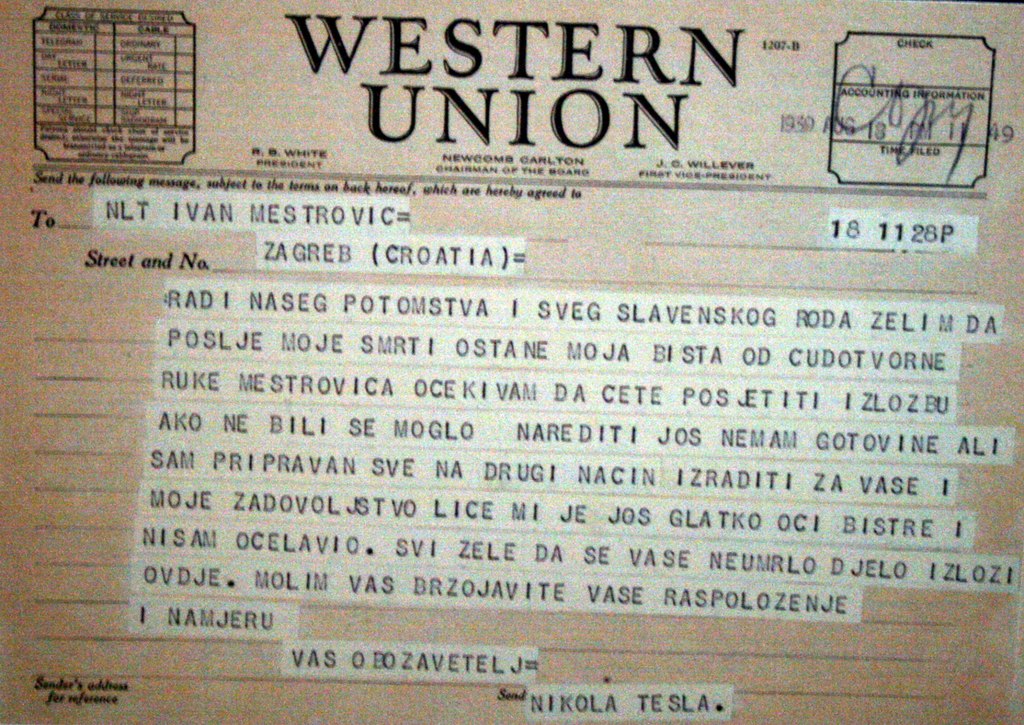‘Your Fan, Nikola Tesla’: When the Great Inventor Met Ivan Meštrović
January 16th 2022 - Ivan Meštrović, a master sculptor and one of the most renowned Croatian artists of all time, died on this day in 1962. A lesser known fact about Meštrović is that he was friends with another famous figure from these parts, the great inventor Nikola Tesla. The two great men met in New York and maintained a decades-long friendship through correspondence
Ivan Meštrović, a master sculptor and one of the most renowned Croatian artists of all time, died on this day in 1962. Having gained United States citizenship a few years earlier, Meštrović passed away in the US, after an illustrious international career and numerous accolades won for his exceptional artistic work.
He was one of the rare Croatian artists to gain international recognition during his lifetime: he lived, worked, taught, and exhibited his art in Split, Paris, Rome, Belgrade, Zagreb, London, Geneva, Cannes, and all over the US. He was the first living artist to get a solo exhibition at the Metropolitan Museum in New York (1947).
Meštrović was the genius mind behind some of the most recognisable landmarks and monuments in Croatia. The Well of Life was installed in front of the Croatian National Theatre in Zagreb in 1912:
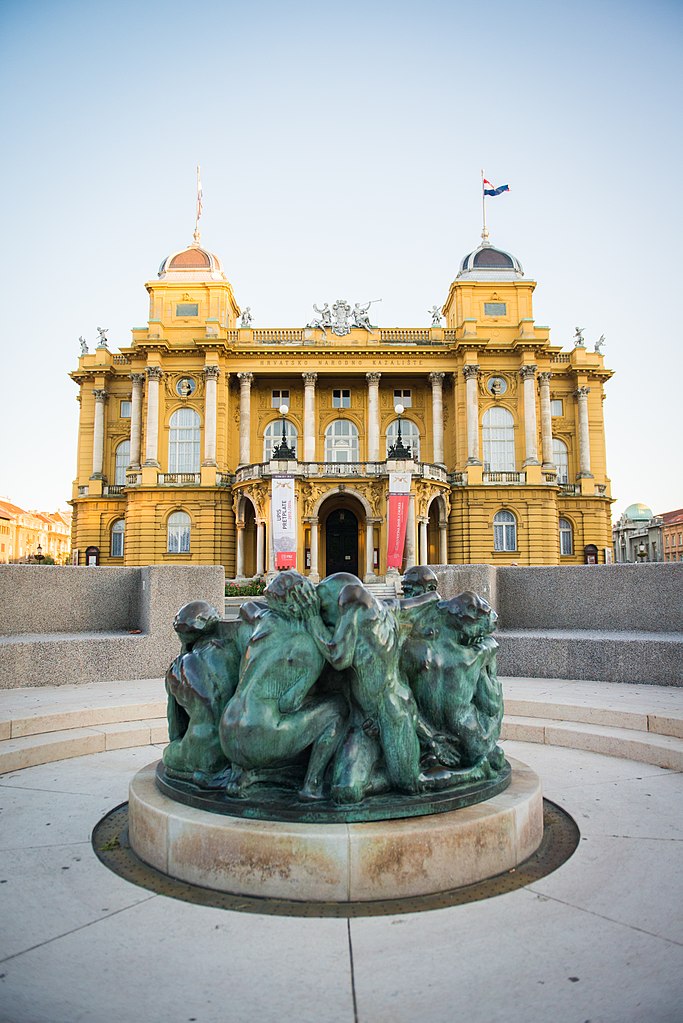
Another iconic landmark in Zagreb, the Home of Croatian Artists also known as Džamija (The Mosque), was designed by Meštrović and completed in 1938 - hence its other nickname, the Meštrović pavilion:
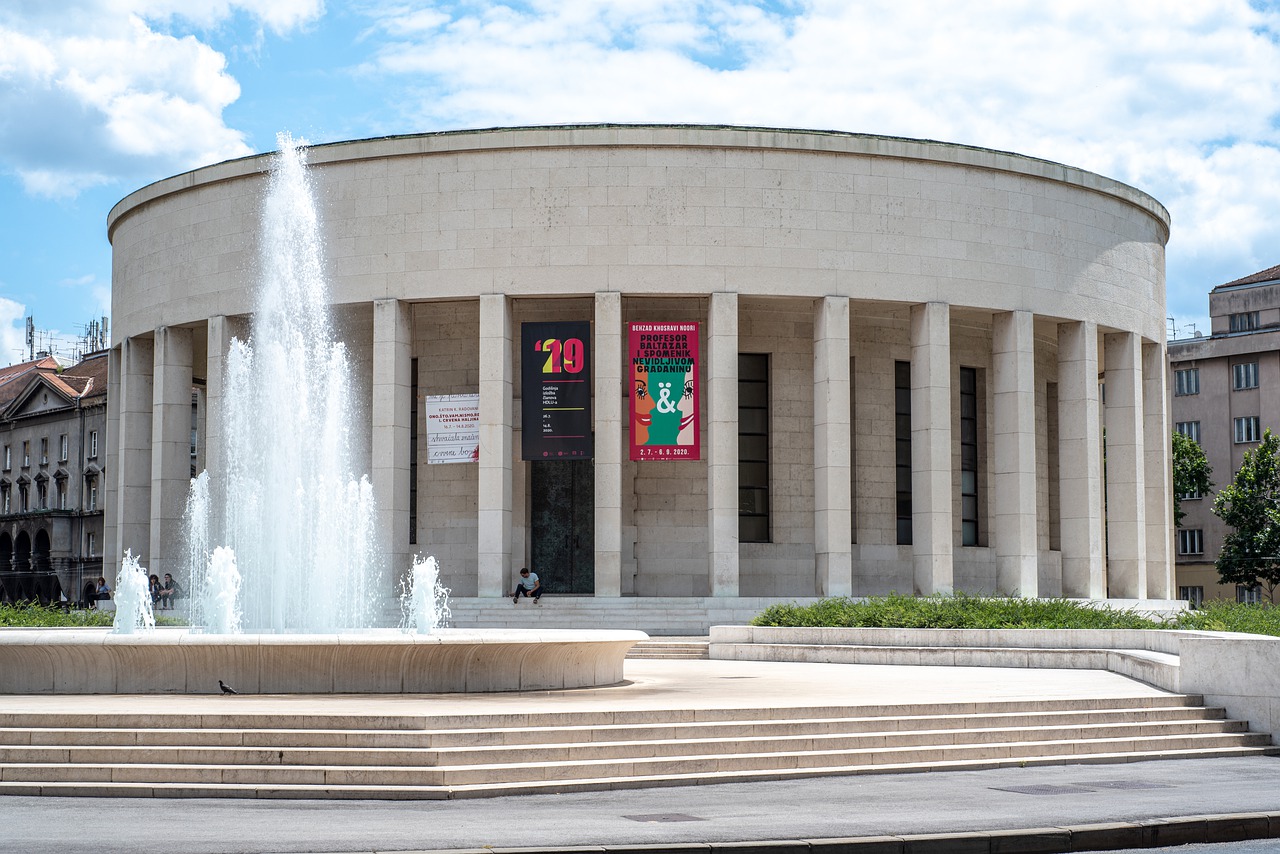
The gigantic statue of Gregory of Nin (Grgur Ninski) was initially installed at the Peristil in Split and later moved to its present location in front of the Golden Gate, where tourists in passing rub the saint’s big toe for luck.

Photo: Statue of Gregorius of Nin in Split, Croatia by Marco Verch under Creative Commons 2.0
A lesser known fact about the master artist is that he was friends with another famous figure from these parts - the great inventor and scientist Nikola Tesla.
Tesla and Meštrović met in New York in 1924, where Meštrović had a solo exhibition at the Brooklyn Museum. Knowing that Tesla was also residing in New York at the time, the artist reached out with a letter expressing his wish to meet, sent from Hotel Gotham on December 13th:
Dear Mr Tesla, one of my main wishes in coming here was to meet you, wrote Meštrović.
Tesla wrote back from Hotel Marguery two days later:
Dear and great artist! I was happy to receive your letter and will be even more glad to meet you in person, as this has been a fervent wish of mine for many years now, replied Tesla with enthusiasm and proposed a meetup time. This was the beginning of a long friendship between the two men, each a master in his own field.
***
In the years that followed, Tesla saw other exhibitions of Meštrović’s work in the US, and wrote to the artist to express his admiration after an exhibition in Chicago in 1929.
They exchanged Christmas cards as well; they are kept at the Nikola Tesla Museum in Belgrade together with the letters and telegrams.
Another touching letter dates to November 12th, 1929 when Meštrović acted as a middleman for Matica srpska, a distinguished Serbian cultural-scientific institution that wanted to publish a biography of the great inventor.
I don’t know why they chose to go through me: either you weren’t replying to them, or they think you and I are closely acquainted making this a more convenient way [to reach you]. I would ask you to accommodate their request, not for their sake or mine, but for the sake of our nation, and most of all for the sake of younger generations who will see in you the most wonderful example of intellectual and moral virtue, urged Meštrović, going on to suggest that Tesla set a condition for his autobiography to be published in both the Latin and Cyrillic script.
***
In a telegram sent in 1939 Nikola Tesla expressed his wish for Meštrović to sculpt a bust of him.
Artists were known to frequently approach Tesla to ask if he would sit for a portrait, and he turned them all down - save for princess Vilma Lwoff-Parlaghy whose drawing was unfortunately lost. That he would personally reach out to Meštrović to commission a portrait bust only speaks to his respect for the master artist.
This is the telegram:
Sent from NYC to Zagreb on August 18th, 1939
The message reads,
For the sake of our descendants and all Slavic people I wish for a bust of me, made by the miraculous hand of Meštrović, to remain after my death. I don’t yet have cash, but I am willing to do everything to your satisfaction and mine by other means. My face is still smooth, my eyes bright, and I haven’t gone bald. Everyone wishes for your immortal work to be displayed here. Please send a telegram to state your opinion and intent. Your fan, Nikola Tesla.
Imagine having Nikola Tesla for a fan.
Meštrović promptly wrote back from Split:
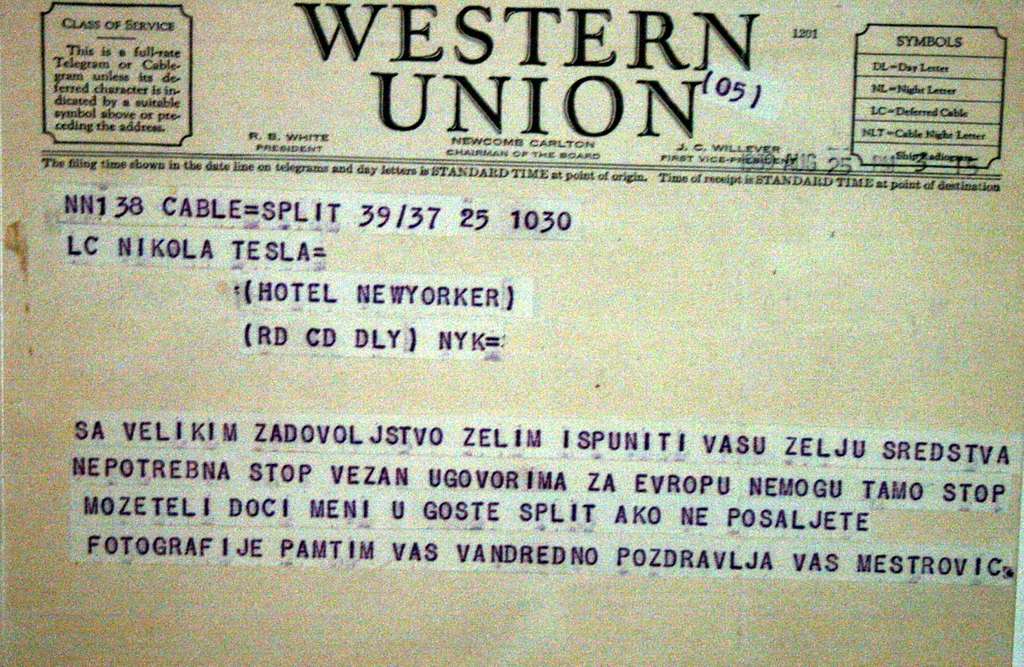
Sent from Split to NYC on August 25th, 1939
The telegram sent to Tesla reads,
It would be my great pleasure to fulfil your wish. Funds not necessary. I am bound by contracts in Europe, I can’t go there [USA]. Can you be my guest in Split, if you can’t, send some photos, I remember you vividly. Greetings from Meštrović.
Tesla was 83 years old at the time and was unable to travel that far, so he didn’t get a chance to pose for Meštrović before he died. The master sculptor kept his word regardless, creating two sculptures of Nikola Tesla in the years that followed.
One is a bronze bust whose original plaster model is displayed at the Croatian Academy of Sciences and Arts in Zagreb; bronze replicas are on display at the Nikola Tesla Museum in Belgrade and the Technical Museum in Vienna.
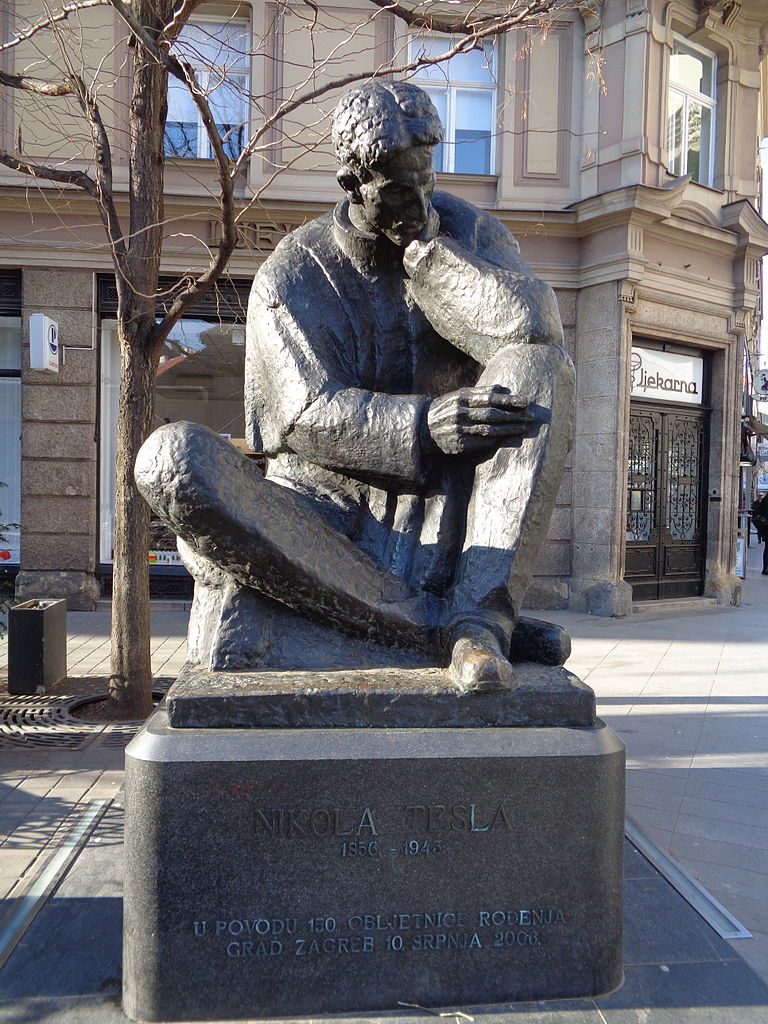
The other is the grand monument of Tesla displayed in Zagreb, shown on the photo above. It was originally installed in front of the Ruđer Bošković Institute in 1956, after Meštrović personally reached out to Croatian physicist Ivan Supek, the founder of the RB Institute. Supek recalled his correspondence with the artist for Jutarnji list/Tanja Rudež.
Meštrović was teaching at the University of Notre Dame in the US at the time, but kept close ties with his homeland. After an earlier sculpture of his, that of Croatian scientist Ruđer Bošković was installed in front of the Institute, he wrote to Supek saying he considered Tesla one of the greatest men from these parts. He said that he would gladly build Tesla a monument and asked for Supek’s opinion - naturally, he agreed, and the work was thus completed and displayed at the institute a year later.
In 2006, the monument was moved to its present location in the city centre, in the street named after Nikola Tesla.
To learn more about Ivan Meštrović and his legacy, visit the pages of Ivan Meštrović Museums / Muzeji Ivana Meštrovića.
Ivan Mestrovic No Longer President of NK Osijek
June 24, 2020 - A big change as the club fights for a spot in the Champions League playoffs, NK Osijek has relieved Ivan Mestrovic of his duties as club president.
Gol.hr reports that one of the best Croatian football clubs, NK Osijek, confirmed on Tuesday what many have speculated in the last few days. Ivan Mestrovic is no longer the president of the club.
"Football Club Osijek continues on the planned path with the same team. However, in slightly changed roles. President Ivan Mestrovic, at his own request and with the understanding of the President of the Supervisory Board and majority owner Lorinac Meszaros, will not continue to operate in the Club for the next four years as president of NK Osijek. However, as the president of the Association of the Football School of our first league, he will exclusively dedicate himself to the completion of the construction of a new football stadium and camp on Pampas," reads the statement from City Garden, which went on to announce Mestrovic's successor.
"The new club president will be the current vice president Ferenc Sakalj, a longtime friend and associate of both Meszaros and Mestrovic. The rest of the club's management remains unchanged and maximally focused on the best possible sports result in the uncertain fight for the top of the HNL championship.
Therefore, in the end, it can be concluded that the co-owners of the Club laughed at the media speculations about conflict, and was determined to continue to jointly fulfill everything that is set in the club's projects and ambitions," reads the announcement of NK Osijek.
Osijek is currently the third-placed team in the First HNL with only one point less than the second-placed Lokomotiva, and the holy second place that leads to the Champions League next season.
To read more about sport in Croatia, follow TCN's dedicated page.
Ivan Meštrović's Sculpture Sold at a Christie's for Over 300,000 Euros
One of the sculptures created by Ivan Meštrović, the Croatian master sculptor, was sold yesterday at an auction in Paris held by the Christie's auction house, for more than six times over the expected price!
The auction house's website shows that. You can see that their estimate of the price is in the range between 30 and 50 thousand euros, while the final price for which it sold stood at a whopping 331,600 euros!
Ivan Meštrović is probably the most famous Croatian sculptor and one of the most famous artists of the 20th century, with his sculptures displayed all over the world, from Zagreb to Chicago.
The Abandoned Woman (Abandonne in French, Napuštena in Croatian) is a remarkable sculpture, made in white marble. Milena Zajović writes for Večernji list about its history: it used to belong to the Italian royal family. Montenegrin princess Elena married into the Italian royal family in 1896 and became the queen in 1900 when her husband Victor Emmanuel III became the king. Queen Elena used to be a friend of Meštrović's, and she probably bought the sculpture from him directly - Christie's says that it was made in 1907, in the early days of Meštrović's career.
The master-piece "The Abandoned Woman" has been shown in public only twice, both times in Vienna, for joint secession exhibitions in 1908 and 1910. The Italian royal probably bought the 58-centimeter high sculpture right after that, and it has belonged to the family since. No one has seen it for decades, and it was considered to have been lost until it appeared at the Christie's auction. The auction house discreetly says that it got to the current owner (before the sale) "by descent."
It has not been made public who the buyer is, as can be expected in such situations. One can only hope that someone in the Croatian governing bodies has decided that this masterpiece needs to come back to Croatia and that Croatia participated in the auction.
Meštrović Gallery to Receive Underground Multimedia Exhibition Hall
The project has received 4.3 million HRK from EU funds just for the projection documentation, which needs to be completed by the end of next year.
Ivan Meštrović in Zagreb – A Guide
Take a walk around Ivan Meštrović's Zagreb.
Happy Birthday Ivan Meštrović from Google Doodle
A nice touch from Google this morning, as the world's most famous and used homepage had a decidedly Split feel.
Today marks 130 years since the birth of world-famous Croatian sculptor Ivan Meštrović, and the search engine has changed its famous homepage doodle to reflect that fact.
Ivan Meštrović is synonymous with Split and its culture. He lived from August 15, 1883 – January 16, 1962 and was a Croatian sculptor and architect. He is renowned as possibly the greatest sculptor of religious subject matter since the Renaissance and the first living person to have a one man show at the Metropolitan Museum of Art in New York City. His work includes perhaps Split's most famous momument, Gregory of Nin at the back of the palace.
The Ivan Meštrović Gallery in Split, which was formed after his major donation in 1950, includes 86 statues in marble, stone, bronze, wood and gypsum, 17 drawings, and also eight bronze statues in the open garden, 28 reliefs in wood in the kaštelet and one stone crucifix.
Learn more about - and take a tour of - the Meštrović complex in Split here.


